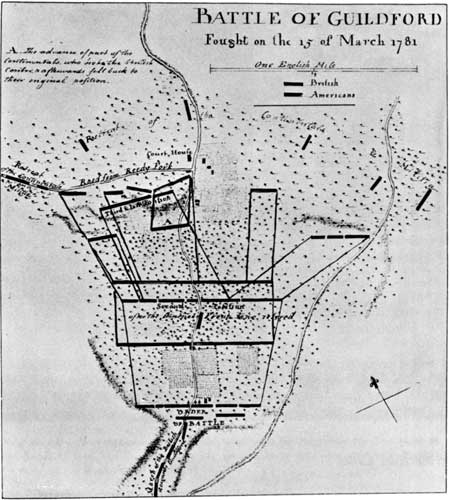|
GUILFORD COURTHOUSE National Military Park |
 |

This plan of battle, engraved for Henry Lee's
Memoirs of the War, is a copy of the so-called Tarleton Map, which was
published in London in 1787. It is not wholly accurate, and the north
point should be rotated 50° to the left for proper
orientation.
Race for the River Crossings
Morgan began a rapid retreat northward and eastward immediately after Cowpens, with Cornwallis in close pursuit. The two armies were then about 25 miles apart. Twenty-three days later, after the Americans had marched about 125 miles airline distance, they had gained 3 miles. When he began to retreat, Morgan sent news of his victory and of his future plans to Greene. Thereupon, Greene set his force in motion northward under Gen. Isaac Huger, while he, himself, with a small escort, joined Morgan near Beatry's Ford on the Catawba River near the present site of Moorseville, N.C. The Yadkin River was crossed a few miles from Salisbury at the Trading Ford, where an overnight rise of 2 feet in the stream prevented the passage of the pursuing British. From that point the Americans continued to Guilford Courthouse, where they were joined by the other half of the army from Cheraw, and whence the retreat was continued toward Virginia.
Cornwallis, unable to use the Trading Ford because of the high water, ascended the Yadkin River to the Shallow Ford, several miles west of the Moravian settlement at Salem.
By this time Greene's plans were fairly evident. He wished to avoid battle, to draw the British as far as possible from their base, and to be able to retire into Virginia if the necessity should arise. To prevent Greene from escaping and in the hope of forcing an engagement, Cornwallis continued the pursuit which developed into a race for the river fords.
The Dan River was deep and could be forded only on its upper reaches; therefore the Englishman interposed his army between Greene and these fords in the expectation that he might compel the Americans to fight. Greene, however, had prepared for just such a contingency and at his direction boats had been built and collected on the south bank of the Dan. In them the Americans safely crossed the river. Cornwallis gave up the chase and marched back to Hillsborough, where he raised the Royal Standard and issued a proclamation calling upon all loyal subjects to rally to his assistance. The results, however, were so disappointing that within a few days his army was again on the march, partly from the necessity of securing food.
Meanwhile, Greene collected reinforcements and rested his army in Virginia. His main object had been to draw Cornwallis away from his base, and, fearing now that he might return to it, Greene recrossed the Dan about March 1. For about 2 weeks he kept on the move, playing for time and position, and avoiding decisive action until he could be joined by the last of the summoned militia reinforcements. These reinforcements arrived in camp on March 13 and 14, and the whole American force immediately marched to Guilford Courthouse where battle stations were taken. Cornwallis was informed of this on the 14th, and early on the next morning he marched from his camp on Deep River to the engagement he had so long sought.

|

| History | Links to the Past | National Park Service | Search | Contact |
|
Last Modified: Mon, Dec 2 2002 10:00:00 am PDT |

